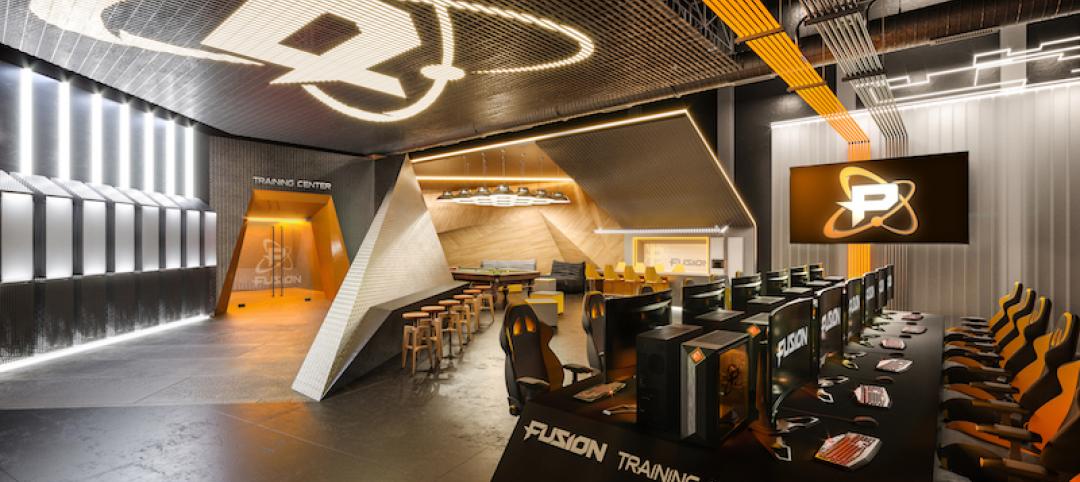The Building Team for Taylor Place faced a devil of a problem-you could even call it a Sun Devil of a problem: how to squeeze two 13-story residence towers for Arizona State University students into a tight 1.21-acre site in downtown Phoenix, even as another large-scale ASU project, the Walter Cronkite School of Journalism and Mass Communications, was being built just across the way.
That they did so, and in only 22 months' time, has earned Gold in this year's Building Team Awards for the Phoenix office of architect/engineering giant SmithGroup; Dallas-based general contractor Austin Commercial; owner/developer Capstone Development Corp., Birmingham, Ala.; and Paul Koehler Consulting Structural Engineers, Scottsdale, Ariz., as well as Arizona State University and the city of Phoenix itself.
The genesis of the project dates to 2005, when Arizona State made a commitment to expand its presence in downtown Phoenix, 15 miles from its main campus in Tempe. Taylor Place, which would provide housing for 1,284 students, and the Cronkite School were seen as crucial fixtures in Phoenix's efforts to inject fresh vitality into its otherwise drab city core.
To meet the tight schedule, the Building Team divided the total project into several packages, with the design staff working far enough ahead to allow the general contractor to be in a position to jump into the next phase of construction; in fact, 80% of the drawings were ready when construction began in May 2007. Project management brought in a hand-picked group of subcontractors during the preconstruction phase to work with the developer, designer, and general contractor to align the budget with Capstone Development's rather ambitious vision for the project.
To move the job along more quickly, Austin Construction dug into its trick bag and pulled out a 20-year-old construction technique known as column-hung shoring. This system, done properly, eliminates the need for re-shoring by transferring the load of the new deck through the column structure itself, rather than through the slab below.
This was crucial for Taylor Place, because the schedule did not allow time for two or three floors of post-shores and re-shores to lag behind the active deck. The technique also allowed MEP work and framing of common exhaust shafts to follow close behind the concrete work. The system also afforded the follow-up trades the opportunity to stock the floors with their MEP, structural, and metal stud framing materials. This allowed them to start their work sooner, thereby cutting labor time for this portion of the project by as much as 50% and increasing overall productivity by an estimated 40%.
The tight site also made crane picks worrisome and constricted the flow of materials deliveries. To overcome these difficulties, the team developed a first come, first served scheduling process whereby all deliveries and crane picks had to be scheduled in the main construction office. This system sped up deliveries and enabled the team to maintain an organized site without the need for a laydown yard.
Quality control was an important consideration for the Building Team. In addition to its own in-house review of details for the buildings' exterior metal panels, window systems, and roofing, the general contractor went so far as to hire a third-party consultant to review all building envelope shop drawings, perform inspections, and conduct performance testing on the wall and roofing systems.
Another QC initiative was the construction of mockups for several of the key architectural features related to the concrete work. These were used not only to confirm that the construction method being employed would work but also to make sure the finish of the concrete was up to the standard set by SmithGroup designers. All mockups had to be approved by the architect, contractor, and the owner, Capstone Development.
The designers took extra steps to make sure the living environment was sensitive to the desert climate. This was accomplished first by siting the structures along an east-west access to maximize natural daylight for occupants while at the same time minimizing openings on the east-west facades to cut down on solar heat gain. Windows on the south facade were fitted with horizontal overhangs to block the summer sun. In the southwest corner of the site, a shaded exterior garden plaza provides a refreshing outdoor oasis for students to lounge in; pedestrians using Taylor and First Streets are protected from the sun by a horizontal cantilevered trellis system incorporated into the building's design.
Capstone Development, which will manage the property in collaboration with ASU for 30 years, threw in every bell and whistle it could think of to make Taylor Place the place for ASU's Phoenix student base to reside: a fitness center, a ground-floor lounge, plasma screen TVs throughout, private study rooms, laundry rooms with online connections to let students know when their clothes are dry, "sky lounges" in the staircases between floors, a 10,000-sf dining hall, and of course wi-fi and cable TV. The top floor features so-called "city-view" rooms with floor-to-ceiling windows. The project includes an 11,000-sf convenience retail mall, although only about 1,100 sf of space has been rented.
While the university did not require LEED certification, the team made sure the project was at least LEED equivalent, according to the chief designer, SmithGroup's Edward F. Garcia, AIA, LEED AP. Active shading devices on all south-facing openings, high-efficiency lighting, programmable thermostats for all regularly occupied spaces, operable windows in the living units, a recycling and sorting facility for residents, low-VOC materials and finishes, and a green housekeeping program were all employed.
To reduce water usage in the desert location, the Building Team specified dual-flush toilets, low-flow bath fixtures, waterless urinals in public areas, and a system to collect condensate from fan coil units for landscape irrigation. This has resulted in an estimated 43% reduction in water usage in the twin towers compared to baseline design.
A key component of the whole process was City Hall's involvement with the Building Team. The city owned a piece of the site, but its main motivation was to inject some life into its relatively moribund downtown, with help from the university. In addition to Taylor Place and the Cronkite School, ASU has also renovated a nearby building for its College of Nursing and the College of Public Programs.
The city assigned a team leader to the project to expedite minor plan revisions through the maze of city hall departments. More importantly, the city established a phased permitting process for Taylor Place. This allowed Tower One to be opened in August 2008 with a temporary certificate of occupancy, just in time for the first group of ASU Sun Devils to settle into their new rooms; Tower Two was completed in early 2009.
Going into its third year of operations, Taylor Place is tracking Capstone Development's four-year lease-up plan nicely, with 85% occupancy set for fall 2010.
PROJECT SUMMARY
Gold Award
Taylor Place: Arizona State University Downtown Student Housing
Phoenix, Ariz.
Building Team
Submitting firm: SmithGroup (architect/engineer, AOR, interior architect)
Owner/developer: Capstone Development Corp.
Structural engineer: Paul Koehler Consulting Structural Engineers, Inc.
General contractor: Austin Commercial
General Information
Project size: 352,000 gsf
Construction cost: $71,007,264
Construction time: May 2007 to February 2009
Delivery method: CM at risk
Related Stories
Architects | Jan 9, 2020
AIA selects recipients for the 2020 Regional & Urban Design Awards
The 2020 Regional & Urban Design program recognizes the best in urban design, regional and city planning and community development.
Building Technology | Jan 7, 2020
Tariff whiplash for bifacial solar modules
Bifacial solar systems offer many advantages over traditional systems.
Sponsored | HVAC | Jan 6, 2020
Maximize Energy Efficiency in Class A Office Buildings With Modern Building Systems
Energy-efficient building design starts with the building envelope, but the building systems have a tremendous impact on energy use as well.
Life of an Architect Podcast | Jan 6, 2020
5 most popular Life of an Architect podcast episodes of 2019
Architects Bob Borson, FAIA, and Andrew Hawkins, AIA, LEED AP, produced 25 episodes of the Life of an Architect podcast in 2019. Here are the five most popular episodes of Life of an Architect based on the number of downloads.
Architects | Jan 6, 2020
Merger expands HED’s presence in SoCal
Puchlik Design Associates, its new addition, specializes in healthcare design.
Steel Buildings | Jan 3, 2020
5 reasons to enter the $20,000 Forge Prize
Calling all emerging architects. Don’t miss out on your chance to enter the $20,000 Forge Prize. Submissions for Stage 1 judging are due January 15.
GIANTS 19 PREMIUM | Dec 23, 2019
Top 90 Sports Facilities Architecture Firms for 2019
Populous, HKS, HOK, Gensler, and HNTB top the rankings of the nation's largest sports facilities sector architecture and architecture engineering (AE) firms, as reported in Building Design+Construction's 2019 Giants 300 Report.
| Dec 18, 2019
Reconsidering construction robotics
After decades when experts predicted that robots would become more prevalent on construction sites, it would appear that the industry has finally reached that point where necessity, aspiration, and investment are colliding.
75 Top Building Products | Dec 16, 2019
Top Window and Door Products for 2019
Pella’s Rolscreen retractable screen and NanaWall’s HSW single-track sliding glass wall are among the 16 window and door products to make Building Design+Construction’s 2019 101 Top Products report.
75 Top Building Products | Dec 16, 2019
Top Structural Products for 2019
Inpro’s Fireline 140 fire barrier and Owens Corning’s Foamglas cellular glass insulation are among the 10 structural products to make Building Design+Construction's 2019 101 Top Products report.
















